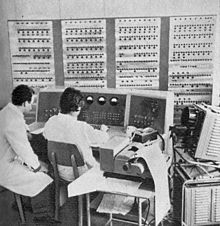
CIFA is the acronym for "Calculatorul Institutului de Fizică Atomică" (English: Computer of Atomic Physics Institute).
CIFA-1, the first Romanian computer, was built in 1957 under the guidance of Victor Toma. The experimental first-generation model CIFA-1 was reproduced in small numbers both in the original variant with vacuum tubes as well as in two variants using transistors: CIFA-10X and CET 500.
CIFA-1 was Romanias contribution to the development of computers in socialist countries (together with the USSR, the GDR, Polish People's Republic and CSSR).
CIFA-1

The logic designs for CIFA-1 started in 1953, at the Academy Physics Institute in Măgurele, with Victor Toma as the head of the project. It was presented at the International Symposium in Dresden in 1955, and the prototype, which used 1500 vacuum tubes, a cylindrical magnet memory and machine code programming, was finished in 1957. Its size was that of three chifforobes, it had a paper tape input and a typewriter output and was able of solving 50 operations per second.
CIFA-1 was in use for two years. After it was decommissioned, it was scrapped and no part of it survived today.
Later computers
Later CIFA computers were CIFA-2 (800 vacuum tubes) in 1959, CIFA-3 (for the Bucharest University's Computer Center) in 1961 and CIFA-4 in 1962. Other Romanian computers of the era are MECIPT-1 (1961), MECIPT-2 (1964) at the Polytechnic Institute of Timișoara, MARICA, DACICC-1 and DACICC-200 at the T. Popoviciu Institute of Numerical Analysis, Cluj-Napoca.
VITOSHA was the first Bulgarian computer, built in 1962-1963 on the basis of a cultural agreement between the Romanian and Bulgarian Academies of Science. It was based on CIFA-3.
CIFA Computer Characteristics
| Computer Model | CIFA-1 | CIFA-4 | CIFA-101 | CIFA-102 |
|---|---|---|---|---|
| Year | 1957 | 1962 | 1962 | 1964 |
| Number of computers produced | 4 | 4 | 1 | 5 |
| Semiconductive diodes | 2500 | 3000 | ||
| Vacuum tubes | 800 | 350 | ||
| Computing speed | 50 op/s | 50 - 2000 op/s | ||
| Internal memory type | cylinder 50 rot/s | cylinder 50 rot/s | ||
| Internal memory capacity | 512 words × 4 bits | 4 k words × 4 bits | ||
| Peripherals | • punch card reader 15 characters/s • writer 8 characters/s |
• punch card reader 15 characters/s • writer 8 characters/s |
• punch card reader 100 characters/s • writer 8 characters/s | |
| Number of instructions | 16 | 32 | ||
| Word length | 31 | 32 | ||
| Word processing mode | parallel | serial | ||
| Power utilization | 5 kW | 1 kW | ||
References
- ^ Vințan, Lucian N. (August 2007). "Maeştri ai ingineriei calculatoarelor. Pagini de istorie" (PDF). Univers Ingineresc. 16 (Year XVIII) (398). Archived from the original (PDF) on February 7, 2012.
- ^ Sandu, Luiza (11 June 2014). "Scurtă istorie a informaticii românești (1957-1990)". Market Watch. No. 165. Retrieved 6 March 2019.
- ^ Drăgănescu, Mihai (2001). "Realizarea de calculatoare şi reţele de calculatoare în România (1953-1985)". Academica. November - December 2001: 43–45.
- Drăgănescu, Mihai (September 2002). "Perspectivele societăţii cunoaşterii în România" (PDF). Communication at the Fifth Scientific Symposium of the Romanian Engineers from Everywhere.
- ^ Baltac, Vasile; Gligor, Horia (19 September 2014). "Some Key Aspects in the History of Computing in Romania" (PDF). Presentation at the 8th IT STAR WS on History of Computing in Szeged.
- ^ Lovin, Tiberiu (13 July 2007). "Tatăl calculatoarelor din țările socialiste". România Liberă. Retrieved 6 March 2019.
- Păvălașc, Marian (16 May 2016). "Originile IT-ul românesc, cel mai performant sector al economiei de azi. Primele calculatoare românești aveau 30 km de cabluri". Libertatea. Retrieved 6 March 2019.
- Cătinaș, Emil (30 November 2018). "Istoricul Institutului de Calcul: Fondarea analizei numerice din România, contribuţii la fondarea informaticii din România". Romanian Academy: Tiberiu Popoviciu Institute of Numerical Analysis. Retrieved 6 March 2019.
- Baltac Vasile, Gligor Horia. https://www.academia.edu/11555241/Some_Key_Aspects_in_the_History_of_Computers_in_Romania "Some Key Aspects of in the History of |Computers in Romania". Proceedings of the 8th IT STAR Workshop on History of Computers. IT STAR 2014: 117–121.
{{cite journal}}: Check|url=value (help)
This computer hardware article is a stub. You can help Misplaced Pages by expanding it. |